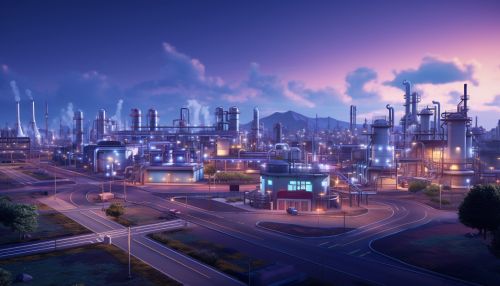Industrial Ecology
Overview
Industrial ecology (IE) is an interdisciplinary field that focuses on the sustainable combination of environment, economy, and technology. The concept of industrial symbiosis, a subset of industrial ecology, involves sharing resources among a network of companies in a way that mimics natural ecosystems. Industrial ecology seeks to quantify the material flows and document the industrial processes that make modern society function.
History
The term "industrial ecology" was first used in the 1970s by American researchers seeking to understand the principles of industrial systems in relation to natural ecosystems. Industrial ecology emerged as a distinct field in the late 1980s and early 1990s, with the publication of several key papers and the establishment of the International Society for Industrial Ecology (ISIE).
Principles
Industrial ecology operates under several key principles. These include the view of industrial systems as part of the larger biosphere, the emphasis on material and energy flow analysis, the promotion of dematerialization and decarbonization, and the application of life-cycle thinking.
Material and Energy Flow Analysis
Material and energy flow analysis (MEFA) is a fundamental tool in industrial ecology. It involves tracking the flow of materials and energy through industrial systems at various scales, from individual processes to global trade networks. MEFA provides a quantitative basis for understanding the efficiency and environmental impacts of these systems.
Life-Cycle Assessment
Life-cycle assessment (LCA) is another key tool in industrial ecology. It involves evaluating the environmental impacts of a product or service throughout its life cycle, from raw material extraction through production, use, and disposal. LCA provides a comprehensive view of the environmental aspects and potential impacts associated with a product or service.
Industrial Symbiosis
Industrial symbiosis involves the mutualistic sharing of resources among a network of companies. This can include the exchange of waste materials, energy, water, and by-products. Industrial symbiosis can lead to significant cost savings, improved resource efficiency, and reduced environmental impact.
Applications
Industrial ecology has been applied in a variety of contexts, including waste management, energy production, product design, and policy making. It has also been used to develop strategies for sustainable development, green building, and corporate sustainability.
Challenges and Criticisms
Despite its potential benefits, industrial ecology faces several challenges and criticisms. These include the difficulty of quantifying and comparing environmental impacts, the lack of standardized methodologies, and the potential for unintended consequences.
Future Directions
The future of industrial ecology lies in addressing these challenges and continuing to refine its tools and methodologies. There is also a need for greater integration with other disciplines, such as economics, sociology, and political science, to better understand and address the complex challenges of sustainability.
See Also


